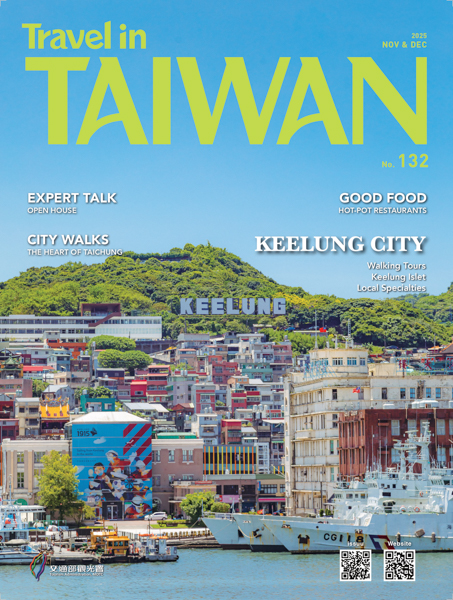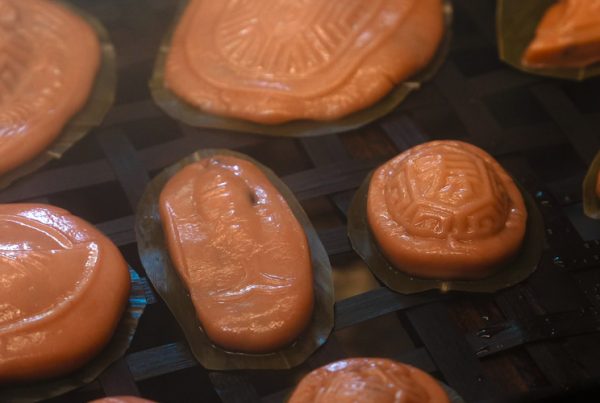An Island Day Trip in Yilan
TEXT | AMI BARNES
PHOTOS | CHEN CHENG-KUO
Often the first landmark glimpsed upon your Lanyang Plain approach, last seen when leaving — if you’re looking for romantic symbols of Yilan County, there are none more potent than Turtle Island. Over the years, this volcanic isle has been the inspiration for geomythical tales, home to fisherfolk and soldiers, and a friendly face for returning homesick travelers. It is also a wonderful place for a day trip.
The distinctively shaped rocky form of Turtle Island guards the horizon off the coast of Yilan. Separated from Taiwan’s mainland by 10km of often choppy ocean, it is only accessible to the general public from March to November when the waters are more conducive to calmer crossings and there is an improved chance of whale/dolphin sightings. And even then, the only visitors are day-trippers (no overnight stays allowed). The Coast Guard Administration oversees all comings and goings, which means anyone hoping to visit needs to pick an itinerary and book through a licensed operator at least three working days in advance so they can assist in arranging the necessary permits. Domestic travelers tend to deal with the boat companies directly, but for international travelers, third-party platforms with English interfaces like KKday or Klook might be easier to navigate.

A quick online search will turn up plenty of tour packages that vary in length and content. The shortest and cheapest (90min, NT$600) is a no-landing cruise around the island, while the full experience (including a guided hike up 401 Plateau and time to explore the island’s abandoned village) takes about six hours and costs around NT$1,500. Regular whale-watching jaunts head further out to where pygmy killer whales and spinner dolphins feast on the bounty brought in by the Kuroshio Current. And a handful of niche operators have specialized offerings such as sunrise sailings or trips that ferry people out to enjoy a spot of paddleboarding or open-water swimming (often complete with drone photography to help you memorialize your escapade).
Whichever package you choose, the journey starts at Wushi Harbor, just a short taxi ride from the railway station in the town of Toucheng, located right in the northeast coastal corner of the Lanyang Plain. On the day of our Travel in Taiwan visit, we rocked up early (you’re asked to arrive 30-60min before your allocated sailing time), presented our ID documents for inspection, and joined the crowd of eager sightseers being assisted onto our boat by a chap with biceps sculpted by years of rope-throwing. We found shaded seats on the upper deck and set off across the water, as our guide launched into an impressively lengthy monologue (in Chinese) explicating aspects of Turtle Island’s history, geology, and ecology.




The journey takes around 30min, and as we drew near, our guide directed our attention to the so-called “Eight Scenic Spots of Turtle Island,” an ensemble of eight lyrically named sights deemed representative of the island’s beauty.
Not all eight have stood the test of time. “Turtle Egg Legend” (a small reef island) vanished after a mysterious nocturnal bang in 1944 – likely an exploding naval mine – while the “Spectacle Caves” (twin sea caves that once looked like a pair of glasses) lost their symmetry in a 2021 rockfall. “Turtle Cliff” is a sheer andesite drop from the turtle’s snout to the sea. “Underwater Hot Springs Gushing Upwards” describes the underwater fumaroles that disgorge milky plumes of mineral-rich water, infusing the ocean with an otherworldly hue (and the air with a distinctive rotten egg perfume). Less frequently, ethereal puffs of volcanic steam called “Turtle Island Sulfur Smoke” are seen dancing over the foreshore. The Yilan locals, never shy about talking about bodily functions, charmingly describe these as the turtle vomiting milk and farting – something to keep in mind when scrolling through Instagram shots of paddleboarders gleefully gliding over… bright-blue turtle puke.


“Turtle Mountain Sunrise” can be observed without even leaving the mainland. Stand on the beach in Zhuangwei Township at the right time of year, and the sunrise aligns nicely with the turtle’s head, as though it’s greeting the new dawn. The final scene is “Turtle God Wears a Hat,” a meteorological phenomenon that occurs when warm sea air rises up the island’s flanks, forming a lone fluffy cloud at the summit. Long used by locals as a reliable indicator of impending rain, this sight is woven into the region’s etiological folklore in the form of a doomed romance between a dragon princess and a turtle. One poetic variation ends with the princess transforming into the Lanyang Plain, and now, whenever her beloved wears the white hat she knitted, she cries – her tears swelling the rivers.


Ashore, we paused at the visitor center before embarking on our trek towards the island’s summit, 401 Plateau. At 1.2km one way, the trail is manageable, but you need to pace yourself – the first stretch climbs steeply through low vegetation, then there’s a brief reprieve followed by a series of even steeper switchbacks. It’s a calf-killer, but it’s also beautiful, especially in April and May when the bell-like forms of wild Formosan lilies line the path. At the summit, a two-story lookout offers sweeping views. Looking west, the turtle’s tail peaks out beyond the trees, while the east-facing head is surrounded by a faint, sulfur-stained halo.









At sea level, a knot of low stone houses sits huddled on the shore of Guiwei Lake. Although the earliest official habitation records date to the 1850s, oral histories suggest fishing families first settled here around 1820, and at its height, the island supported some 700 hardy souls. Island life was tough – nothing beyond an elementary school, little fresh produce, and medical care was a boat ride away. Despite these hardships, the islanders were reluctant to move, and it took a particularly brutal typhoon season to provoke a mass exodus. In 1977, the entire population relocated to the nearby town of Daxi, and once they left, there was no going back – the military moved in, closing the wharf to civilians for decades. Their new home, though barely 10km away, might as well have been on the other side of the Pacific Ocean.



Evidence of the military presence, which ended in 2000, still lingers. A statue of the island’s patron deity, Guanyin, arrived during this time (overlooking Guiwei Lake), and the soldiers dug a subterranean tunnel network – some of which is now open to visitors. If you visit in summer – as we did – you’ll likely want to hang out in the tunnels as you await your homeward sailing, because they’re cool, breezy, and offer a much better escape from the heat than even the air-conditioning in the visitor center.









